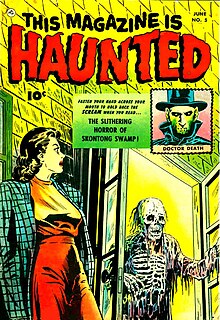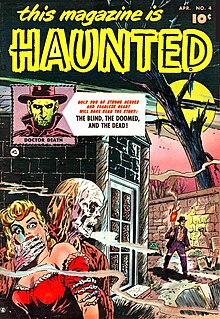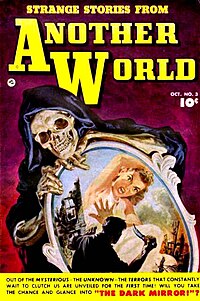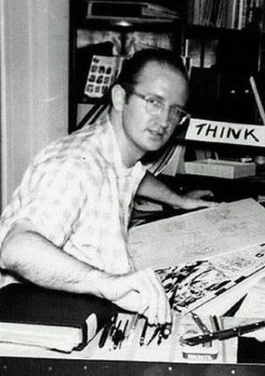
Stephen John Ditko was an American comics artist and writer best known for being the co-creator of Marvel superhero Spider-Man and creator of Doctor Strange. He also made notable contributions to the character of Iron Man, revolutionizing the character's red and yellow design.
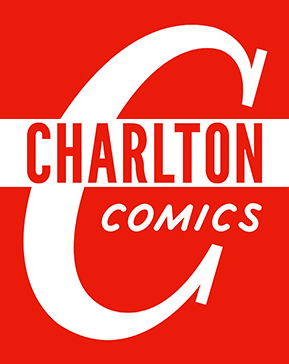
Charlton Comics was an American comic-book publishing company that existed from 1945 to 1986, having begun under a different name: T. W. O. Charles Company, in 1940. It was based in Derby, Connecticut. The comic-book line was a division of Charlton Publications, which published magazines, puzzle books, and briefly, books. It had its own distribution company.

Fawcett Comics, a division of Fawcett Publications, was one of several successful comic book publishers during the Golden Age of Comic Books in the 1940s. Its most popular character was Captain Marvel, the alter ego of radio reporter Billy Batson, who transformed into the hero whenever he said the magic word "Shazam!".

The Vault of Horror was an American bi-monthly horror comic anthology series published by EC Comics in the early 1950s. Along with Tales from the Crypt and The Haunt of Fear, it formed a trifecta of popular EC horror anthologies. The Vault of Horror hit newsstands with its April/May 1950 issue and ceased publication with its December/January 1955 issue, producing a total of 40 issues.
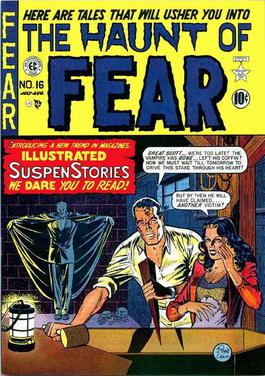
The Haunt of Fear was an American bi-monthly horror comic anthology series published by EC Comics, starting in 1950. Along with Tales from the Crypt and The Vault of Horror, it formed a trifecta of popular EC horror anthologies. The Haunt of Fear was sold at newsstands beginning with its May/June 1950 issue.
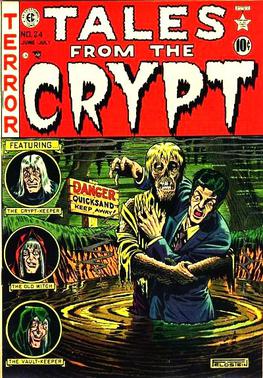
Tales from the Crypt was an American bi-monthly horror comic anthology series published by EC Comics from 1950 to 1955, producing 27 issues. Along with its sister titles, The Haunt of Fear and The Vault of Horror, Tales from the Crypt was popular, but in the late 1940s and early 1950s comic books came under attack from parents, clergymen, schoolteachers and others who believed the books contributed to illiteracy and juvenile delinquency. In April and June 1954, highly publicized congressional subcommittee hearings on the effects of comic books upon children left the industry shaken. With the subsequent imposition of a highly restrictive Comics Code, EC Comics publisher Bill Gaines cancelled Tales from the Crypt and its two companion horror titles, along with the company's remaining crime and science fiction series in September 1954.

John Thomas Alexis Craig, was an American comic book artist notable for his work with the EC Comics line of the 1950s. He sometimes used the pseudonyms Jay Taycee and F. C. Aljohn.

L. Miller & Son, Ltd. was a British publisher of magazines, comic books, pulp fiction and paperback books intended primarily to take advantage of the British ban on importing printed matter. Between 1943 and 1966, the firm published British editions of many American comic books, primarily those of Fawcett Comics and American paperback books, primarily those of Fawcett Publications' Gold Medal Books. The company is best known for the 1954 creation of Marvelman – a blatant imitation of the Golden Age Captain Marvel – after America's Fawcett Publications capitulated to National Periodicals. L. Miller & Son also published a large line of Western comics — many reprints but also some original titles - and both category fiction and non-fiction paperbacks.

Crestwood Publications, also known as Feature Publications, was a magazine publisher that also published comic books from the 1940s through the 1960s. Its title Prize Comics contained what is considered the first ongoing horror comic-book feature, Dick Briefer's "Frankenstein". Crestwood is best known for its Prize Group imprint, published in the late 1940s to mid-1950s through packagers Joe Simon and Jack Kirby, who created such historically prominent titles as the horror comic Black Magic, the creator-owned superhero satire Fighting American, and the first romance comic title, Young Romance.
William Fraccio was an American comic book artist whose career stretched from the 1940s Golden Age of comic books through 1979, when he turned to producing advertising art and teaching. He is best known for his 23-year run at Charlton Comics, where he illustrated, among many other things, the first two professional stories of future Marvel Comics editor-in-chief Roy Thomas.

Sheldon "Shelly" Moldoff was an American comics artist best known for his early work on the DC Comics characters Hawkman and Hawkgirl, and as one of Bob Kane's primary "ghost artists" on the superhero Batman. He co-created the Batman supervillains Poison Ivy, Mr. Freeze, the second Clayface, and Bat-Mite, as well as the original heroes Bat-Girl, Batwoman, and Ace the Bat-Hound. Moldoff is the sole creator of the Black Pirate. Moldoff is not to be confused with fellow Golden Age comics professional Sheldon Mayer.

The Many Ghosts of Doctor Graves is an American supernatural-anthology comic book that was published by Charlton Comics, often featuring stories by writer-artist Steve Ditko. The eponymous Dr. M. T. Graves was a fictional character who hosted the stories in each issue of this title, and very occasionally took part in a tale.

Horror comics are comic books, graphic novels, black-and-white comics magazines, and manga focusing on horror fiction. In the US market, horror comic books reached a peak in the late 1940s through the mid-1950s, when concern over content and the imposition of the self-censorship Comics Code Authority contributed to the demise of many titles and the toning down of others. Black-and-white horror-comics magazines, which did not fall under the Code, flourished from the mid-1960s through the early 1980s from a variety of publishers. Mainstream American color comic books experienced a horror resurgence in the 1970s, following a loosening of the Code. While the genre has had greater and lesser periods of popularity, it occupies a firm niche in comics as of the 2010s.
Alan Class Comics was a British comics publishing company that operated between 1959 and 1989. The company produced anthology titles, reprinting comics stories from many U.S. publishers of the 1940s to 1960s in a black and white digest size format for a UK audience. During the 1960s and 1970s, these reprints were the main medium through which British children were introduced to American monster and mystery comics, as well as most non-DC or Marvel superheroes.

Space Adventures is an American science-fiction anthology comic book series that was published sporadically by Charlton Comics from 1952 to 1979. Its initial iteration included some of the earliest work of industry notables Steve Ditko, Dick Giordano, and Tony Tallarico, and at least one story by EC Comics mainstay Bernard Krigstein.
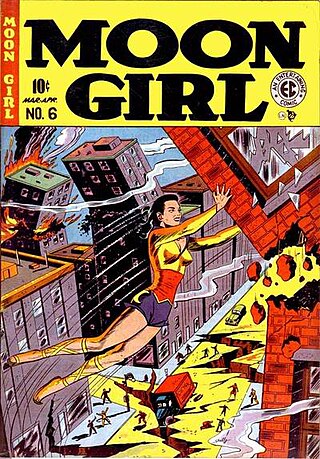
Moon Girl is a fictional character published by EC Comics from 1947 to 1949. Moon Girl is a character from the Golden Age of Comic Books and has since passed into the public domain. Her secret identity is Claire Lune, a junior high history teacher.

Ghostly Tales is a horror-suspense anthology comic book series that was published by Charlton Comics from 1966 to 1984. The book was "hosted" by Mr. L. Dedd, a middle-aged gentleman with purplish skin and horns who dressed like a vampire. Mr. Dedd spun his "ghostly tales" from the parlor of his "haunted house".

Ghost Manor is a horror-suspense anthology comic book series that was published by Charlton Comics from 1968 to 1984. Volume one was "hosted" by the Old Witch, while volume two was hosted by Mr. Bones.

Ghostly Haunts is an American horror-suspense anthology comic book series that was published by Charlton Comics from 1971 to 1978. The book was "hosted" by Winnie the Witch, a "moddish" blue-skinned witch.
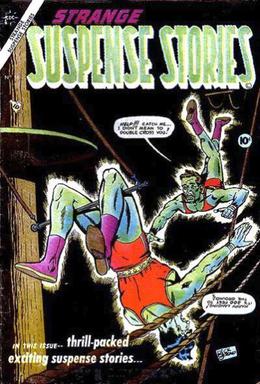
Strange Suspense Stories is a comic book that was published in two volumes by Fawcett Comics and Charlton Comics in the 1950s and 1960s. Starting out as a horror/suspense title, the first volume gradually moved toward eerie fantasy and weird science fiction, before ending as a vehicle for the superhero Captain Atom. The title's second volume was more in the horror/suspense vein. Altogether, 72 issues of Strange Suspense Stories were published.
